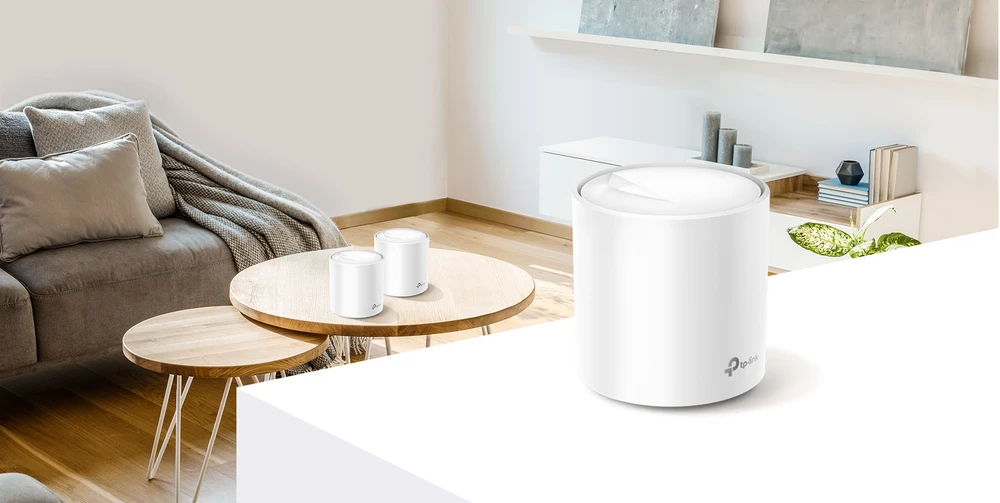 Click to enlarge!
Click to enlarge!

 Click to enlarge!
Click to enlarge!
HomeCare
Seamless roaming with one Wi-FI name
QoS
QoS tools to protect against malware include malicious content filtering for all connected devices, intrusion prevention and isolation of infected devices. Homecare QoS settings offer several optimized presets including; Standard, Game, Stream, Surfing, Chat and Custom. Here you can also provide individual customers with high bandwidth priority with specific allocations.
Mobile app
You can manage the X60 via the TP-Link Deco mobile app or via the web console. When you launch the app, you'll see the main overview screen with the network name and its internet status, and a list of currently connected clients.
From the technical point of view, each Deco X60 unit has been equipped with a quad-core processor working at 1GHz. Additionally, inside you'll also find 512MB of RAM for more stable operation, and 128MB of ROM for storing data. Each accessory is equipped with four internal omni-directional antennas that transmit wireless signals using all modern standards, including Wi-FI 6 (802.11ax).
| Technical data: | |
| Dimensions | 110 × 110 × 114 mm |
| Antenna type | Four internal dual-band antennas |
| Security standard | WPA2 / WPA3 |
| Interface | 2 Gigabit Ethernet ports |
| Wireless network standard | IEEE 802.11ax / ac / n / a 5 GHz // IEEE 802.11ax / n / b / g 2.4 GHz |
| Signal speed | 574 Mbps in the 2.4GHz band and 2402Mbps in the 5GHz band |
| Additional features | Compatible with Alexa, Ethernet Backhaul |
Deco X60 is much smaller than a classic router, and the device itself is made of white matte plastic. The cylindrical shape is visually attractive, thanks to this design TP-Link Deco X60 fits into any kind of interior.
The device is just over 10cm high and can be easily placed on a shelf or cabinet. At the bottom there is a label with the most important information, such as the name of the default Wi-FI network and a reset button, so you can reset the Deco to factory settings. On the back there is a jack and two Gigabit Ethernet ports. On the front of the device, just below the manufacturer's logo, there is a hidden indicator LED that informs us about the operating status.| Flashing green/white | Firmware Upgrade |
| Flashing yellow | Resetting the device |
| Flashing blue | Device in the process of configuration |
| Diode | State of Deco |
| Red | The device encountered a problem |
| Yellow | Putting the device into operation |
| Flashing red | Device is not connected to the main unit |
| Green/white | Device registered and functioning properly |
 Click to enlarge!
Click to enlarge!
The application with its good, interesting and clear graphics guides us through the entire configuration process. In this case, even a less advanced user will not have any problems with connecting the device correctly. Once the main Deco router has been configured and connected to the Internet, we can start connecting other devices. To do this, install another Deco X60 in the location of your choice, then after about two minutes the system will automatically detect and add the device to your Mesh network

TrendMicro's Homecare module provides access to useful security tools that filter malicious content, prevent intrusions and external attacks, and quarantine infected devices.
A simple cloud-based solution that helps block inappropriate online content on all children's devices. In addition, we can set a limit on the amount of time our kids can spend online.
Advanced QoS module, helps you easily configure network traffic priorities for gaming, streaming, chatting, browsing or other activities.
You can use it to perform quick speed tests and see how fast your Internet connection is when using the TP-Link Deco X60.
A newer, more secure encryption protocol for wireless networks.
Enable one wireless guest network that broadcasts its signal in the 2.4GHz and 5GHz bands simultaneously.
Supports IPv6 addresses that replace IPv4.
You can pair Amazon Alexa devices to control the Deco X60 with simple voice commands.
The testing device was a MacBook Pro A1502 with built-in AirPort Extreme wireless card (Broadcom BCM4360 3x3, 1.3 Gbps PHY) working in 802.11a/b/g/n/ac standards.
Before speed testing, we verified the maximum performance of the LAN and iperf3 server. The aforementioned laptop was connected via a 10/100/1000Mbps network card to the switch.We obtained the following maximum speeds for a single TCP stream:
Accesspoints Deco-1, Deco-2 and Deco 3 were connected to each other in Mesh mode only, i.e. wireless only.
 Click to enlarge!
Click to enlarge!
 Click to enlarge!
Click to enlarge!
 Click to enlarge!
Click to enlarge!
 Click to enlarge!
Click to enlarge!
 Click to enlarge!
Click to enlarge!
 Click to enlarge!
Click to enlarge!
 Click to enlarge!
Click to enlarge!
 Click to enlarge!
Click to enlarge!
 Click to enlarge!
Click to enlarge!
 Click to enlarge!
Click to enlarge!
 Click to enlarge!
Click to enlarge!
 Click to enlarge!
Click to enlarge!
 Click to enlarge!
Click to enlarge!